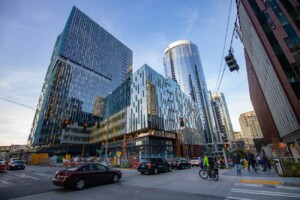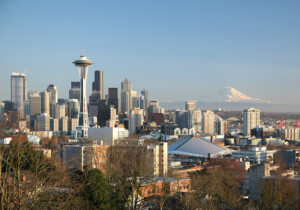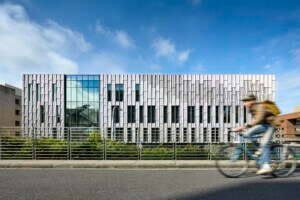Like many regions across the country, Seattle is still recovering from the Great Recession, especially when it comes to housing construction.
According to the Seattle Times, rents citywide went up 9.7 percent last year, outpacing increases in every other American city and fueling displacement, gentrification, and overall income inequality. At the same time, the economy has picked up: A recent report by consultants Rider Levett Bucknall listed Seattle as having 58 cranes in operation, more than any other city in the country. Not only that, but the Seattle region added roughly 700,000 residents (roughly the population of Seattle proper) between 2000 and 2014 and is expected to add at least as many in coming decades.
As the economy surges, so does development. This is especially true of projects fueled by—and for—tech-industry juggernauts like Amazon, which is building a NBBJ-designed, 3.3-million-square-foot headquarters in Seattle’s Denny Regrade neighborhood. A condominium tower suburb is sprouting up alongside the new headquarters, too, with an untold number of high-end and luxury units due to come online in that corner of the city over the next few years. There are at least 26 new high-rise developments in the works in the area, with between 10,000 and 30,000 units currently permitted or in pre-development according to a study by Realogics Sotheby’s International Realty.
In step with the building boom, a different sort of pro-growth tide is washing ashore: YIMBYism. The so-called YIMBY (Yes In My Backyard) movement is growing rapidly in many American cities, especially across the West, where high rents, increasing urban density, and social justice issues are bringing together broad—and sometimes uneasy—coalitions of more-or-less pro-development voices. The difference is that the voices at the table—anti-displacement working poor communities, pro-density yuppies, and the Black Lives Matter (BLM) movement—are more focused and diverse than your run-of-the-mill “build, baby, build!” crowd.
This new crop of urbanists advocates development to address complex, intersecting issues like mitigating climate change, increasing access to affordable housing, expanding transportation options, and building design justice into the urban fabric.
The groups have rallied around disparate causes, either advocating for or against new development and so far, they’ve had several successes.
One of the groups’ most notable achievements was to block the construction of the $149.2 million North Precinct police station in Seattle. The project, designed by Portland, Oregon–based SRG Partnership, would have brought a 105,000-square-foot facility to a northern part of the city. The project, dubbed “The Bunker” by the BLM activists and a group called Block The Bunker who most fervently fought the proposal, was widely seen as an extension of the city’s ever-growing police state and represented, in the minds of these activists, a misallocation of community resources. Though these groups are not formally affiliated with other pro-development YIMBY groups, their efforts to bake racial and design justice into Seattle’s urban fabric add a much needed anti-racism component to the city’s chorus of urbanist voices. After a coordinated and cooperative protest in the streets and at city council meetings by anti-Bunker activists, the project was terminated. In his announcement, Capitol Hill Seattle reported that Mayor Ed Murray said the following about the station: “I inherited the [North Precinct] proposal and I made a mistake about not stopping [it].” He added that his office neglected to abide by the city’s racial equity toolkit while pursuing the project. Activists sought to redirect funding for what would have been the most expensive police station in the country toward beneficial community uses—they argued that the money should be used to build 1,000 units of affordable housing.
Another group called No New Youth Jail—also led by people of color and anti-racism advocates—is fighting to stop the construction of a new King County-funded youth detention center in the city, as well.
A different coalition came together this fall to pass Proposition 1, a ballot ordinance to raise $54 billion to expand transit options in the city. The proposition, also known as “Sound Transit 3,” passed with 55 percent support across a three-county area. The proposition aims for a new round of permanent tax increases to fund 10 light rail extensions and three bus-rapid transit extensions across Snohomish, King, and Pierce counties by 2041. As the name implies, Sound Transit 3 represents the third such measure to pass since 1996.
Activist urbanists were also instrumental in pushing Mayor Murray to increase the zoning density allowed around north Seattle’s U-District, adjacent to the University of Washington. The change is the first to be implemented since the city adopted a new Mandatory Housing Affordability (MHA-R) policy requiring developers to either include affordable units in every new multifamily residential and commercial project in upzoned areas project or pay into a fund used to build affordable units off-site. The U-District upzone calls for raising maximum building heights from 65 feet to 320 feet, among other things, and was designed in anticipation of a new Link light rail line expected to open in 2021.










